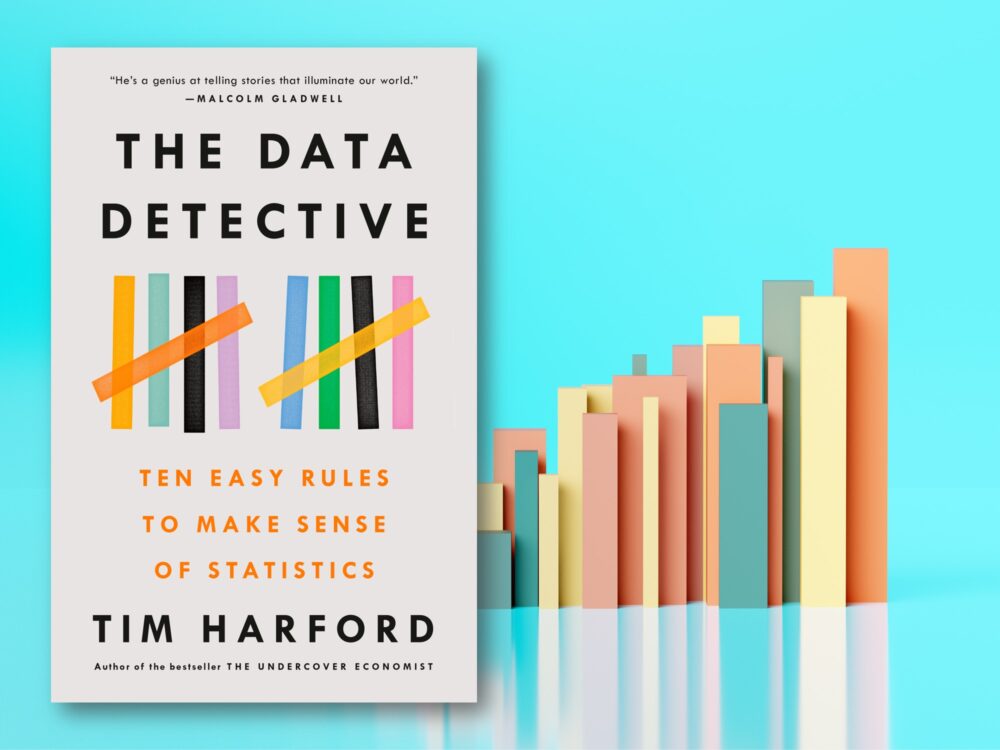Overview
‘The Data Detective: Ten Easy Rules to Make Sense of Statistics’ by Tim Harford is a guide to understanding and interpreting statistics in a world where data is increasingly prevalent. Harford, known for his engaging writing style, breaks down complex statistical concepts into ten simple rules that help readers navigate the often confusing world of data. He emphasises the importance of approaching statistics with curiosity and scepticism, encouraging readers to question their own biases and assumptions. By using real-world examples and stories, Harford makes the subject accessible and relevant, showing how statistics can be used to make better decisions in everyday life.
The book also delves into the psychological aspects of how we perceive and interpret data. Harford draws on research from psychology and behavioural science to explain why we often misunderstand statistics and how we can overcome these pitfalls. He advocates for a more thoughtful and patient approach to data, one that values critical thinking and open-mindedness. “The Data Detective” is not just a book about numbers; it is a call to become more informed and discerning consumers of information, equipping readers with the tools to see through the noise and make sense of the world around them.
Synopsis
‘The Data Detective: Ten Easy Rules to Make Sense of Statistics’ by Tim Harford is a 336-page book divided into ten chapters.
- Search Your Feelings: This chapter emphasises the importance of recognising and understanding our emotional responses to data. Harford explains how our feelings can influence our interpretation of statistics and encourages readers to be aware of their biases.
- Ponder Your Personal Experience: Harford discusses the value of personal experience in understanding data. He argues that while personal anecdotes can be insightful, they should be balanced with broader statistical evidence to avoid misleading conclusions.
- Avoid Premature Enumeration: This chapter warns against jumping to conclusions based on incomplete data. Harford advises readers to take the time to gather sufficient information before making any statistical claims.
- Step Back and Enjoy the View: Harford encourages readers to look at the bigger picture when analysing data. This chapter highlights the importance of context and the dangers of focusing too narrowly on specific data points.
- Get the Backstory: This chapter delves into the importance of understanding the background and context of data. Harford explains how knowing the history and circumstances behind statistics can lead to more accurate interpretations.
- Ask Who Is Missing: Harford discusses the significance of considering who or what might be excluded from data sets. This chapter explores the biases that can arise from missing data and how to account for them.
- Demand Transparency: This chapter focuses on the need for transparency in data collection and analysis. Harford stresses the importance of understanding how data is gathered and processed to ensure its reliability.
- Don’t Take Statistical Bedrock for Granted: Harford advises readers to question the foundational assumptions behind statistical analyses. This chapter explores how even widely accepted statistical methods can have limitations and biases.
- Remember That Misinformation Can Be Beautiful Too: This chapter examines how misinformation can be presented in a convincing manner. Harford provides tips on how to critically evaluate data to avoid being misled by attractive but false statistics.
- Keep an Open Mind: Harford concludes by encouraging readers to remain open-minded and curious when dealing with data. This chapter emphasises the importance of continuous learning and adapting one’s understanding based on new information.
Why you should read it?
The book is a valuable read for both the general public and specialised audiences. For the general reader, the book demystifies the often intimidating world of statistics, making it accessible and engaging. Harford’s use of real-world examples and storytelling helps illustrate complex concepts in a relatable way, encouraging readers to think critically about the data they encounter in everyday life. This is particularly important in an age where misinformation is rampant, and the ability to discern credible information from misleading statistics is crucial.
For specialised audiences, such as data analysts, researchers, and professionals in fields that rely heavily on data, Harford’s book offers practical insights and a fresh perspective on statistical analysis. The ten rules outlined in the book serve as a useful framework for approaching data with a critical eye, ensuring that analyses are thorough and unbiased. Harford’s emphasis on transparency, context, and the psychological aspects of data interpretation provides valuable lessons for improving the accuracy and reliability of statistical work. Overall, ‘The Data Detective’ equips both general and specialised readers with the tools to navigate the complexities of data in a thoughtful and informed manner.
Critics and review
The book has been well-received by both readers and critics, earning praise for its engaging and accessible approach to understanding statistics. On Goodreads, the book holds an average rating of 4.12 out of 5. Readers appreciate Harford’s ability to simplify complex statistical concepts and his use of real-world examples to illustrate his points. Many reviews highlight the book’s practical advice and its relevance in today’s data-driven world, making it a valuable resource for anyone looking to improve their data literacy.
On Amazon, the book has an impressive average rating of 4.4 out of 5. Reviewers commend Harford for his clear writing style and his ability to make statistics both interesting and understandable. The book has been described as thought-provoking and insightful, with many readers finding it useful for both personal and professional development.
Overall, “The Data Detective” is celebrated for its timely and important message, encouraging a more thoughtful and sceptical approach to the statistics we encounter every day.
Verdict
‘The Data Detective’ is a masterfully written guide that demystifies the world of statistics with clarity and wit. Harford’s engaging storytelling and practical advice make complex concepts accessible to all readers, empowering them to navigate the data-driven world with confidence and critical thinking. The book’s blend of real-world examples, psychological insights, and actionable rules provides a comprehensive toolkit for understanding and interpreting data, making it an invaluable resource for anyone looking to enhance their data literacy and make more informed decisions.
About the authors
Tim Harford is a renowned English economist, journalist, and broadcaster, best known for his long-running Financial Times column, ‘The Undercover Economist’, which explores the economic ideas behind everyday experiences. Harford’s work primarily focuses on making complex economic concepts accessible to the general public. He has authored several influential books, including ‘The Undercover Economist’, ‘Adapt: Why Success Always Starts with Failure’, ‘Messy: The Power of Disorder to Transform Our Lives’ and ‘Fifty Inventions That Shaped the Modern Economy’. In addition to his writing, Harford presents the BBC Radio 4 programme ‘More or Less’, which examines the numbers and statistics behind news stories.
Harford’s contributions to economic journalism and public understanding of statistics have earned him numerous accolades, including the Bastiat Prize for economic journalism and an honorary fellowship from the Royal Statistical Society. Despite his widespread acclaim, Harford has faced some criticism, particularly regarding the practicality of his ideas in real-world applications. However, his ability to communicate complex ideas in an engaging and relatable manner continues to make him a respected and influential voice in the field of economics.
#BookReview #Statistics #DataLiteracy #TimHarford #BooksIlikeEu








Leave a Reply